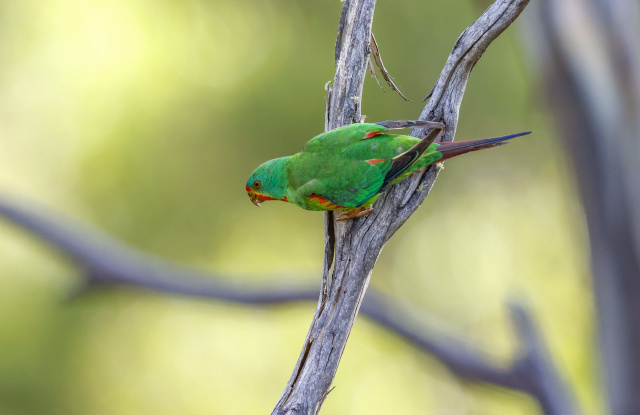Bruny Island: Critical habitat site for birds
In my role in BirdLife Australia, we have a woodland bird conservation action plan. It identifies 51 in decline species across woodlands from Tasmania, all the way up to Queensland. And those species are in rapid decline. There are a number of those birds that are listed Federally as Threatened, and that includes the 40-Spotted Pardalote, and the Swift Parrot.
Cover Image: Forty-Spotted Pardalote, Kim Murray

It has nest hollows and suitable forage and flowering trees within their foraging range, needed for them to maintain their population, that is ever declining. This is the habitat that the Swift Parrots require each year to produce their two or three young in a nest in their hollows. But it is also an island that is free of the Sugar Glider – a key introduced predator for the bird.
The available habitat, and that expansive habitat, that expansive forest remnant habitat, is really important for those Swift Parrots. They breed in the hollows, and then they move about, in a 9 - 10 kilometre range, in search for blossom, because they also are feeding while they're raising their chicks.
They need that expansive habitat.


Lyndel Wilson
In my role in BirdLife Australia, we have a woodland bird conservation action plan. It identifies 51 in decline species across woodlands from Tasmania, all the way up to Queensland. And those species are in rapid decline. There are a number of those birds that are listed Federally as Threatened, and that includes the 40-Spotted Pardalote, and the Swift Parrot.
Cover Image: Forty-Spotted Pardalote, Kim Murray

It has nest hollows and suitable forage and flowering trees within their foraging range, needed for them to maintain their population, that is ever declining. This is the habitat that the Swift Parrots require each year to produce their two or three young in a nest in their hollows. But it is also an island that is free of the Sugar Glider – a key introduced predator for the bird.
The available habitat, and that expansive habitat, that expansive forest remnant habitat, is really important for those Swift Parrots. They breed in the hollows, and then they move about, in a 9 - 10 kilometre range, in search for blossom, because they also are feeding while they're raising their chicks.
They need that expansive habitat.

You might like...

Birds of Gilgit-Baltistan

Plight of the shorebirds

Birdlife Australia: Saving Birds, Saving Life

Birds playing in wind at the neck
Newsletter
Sign up to keep in touch with articles, updates, events or news from Kuno, your platform for nature
